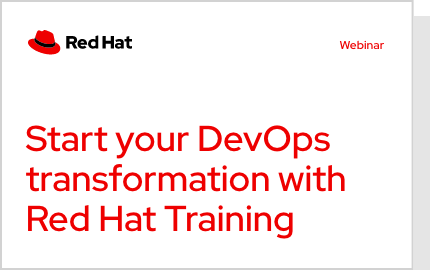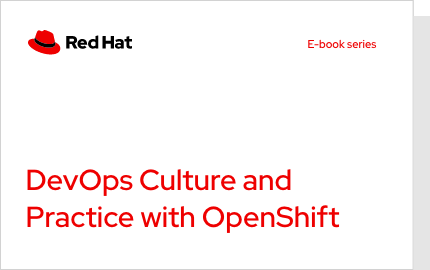What is DevOps, anyway?
The word "DevOps" is a mashup of "development’ and "operations" but it represents a set of ideas and practices much larger than those two terms alone, or together. DevOps includes security, collaborative ways of working, data analytics, and many other things. But what is it?
DevOps describes approaches to speeding up the processes by which an idea (like a new software feature, a request for enhancement, or a bug fix) goes from development to deployment in a production environment where it can provide value to the user. These approaches require that development teams and operations teams communicate frequently and approach their work with empathy for their teammates. Scalability and flexible provisioning are also necessary. With DevOps, those that need power the most, get it—through self service and automation. Developers, usually coding in a standard development environment, work closely with IT operations to speed software builds, tests, and releases—without sacrificing reliability.
Of course, this means more frequent changes to code and more dynamic infrastructure usage. Traditional management strategies can’t keep up with this kind of demand. You’re going to need to change a few things to give you an edge.
What do containers have to do with DevOps?
Containers make it easier to move applications between development, testing, and production environments. Using containers lets developers package and isolate their apps with everything they need to run, including application files, runtime environments, dependent libraries and configurations.
DevOps speeds up how an idea goes from development to deployment. At its core, DevOps relies on automating routine operational tasks and standardizing environments across an app’s lifecycle. Containers can offer standardized environments, but you need a platform to manage them that also offers built-in automations and support for any infrastructure. Red Hat OpenShift is the enterprise-ready Kubernetes platform to support DevOps initiatives.
DevOps culture
DevOps relies on a culture of collaboration that aligns with open source principles and transparent, agile approaches to work. You can immerse yourself in an exploration of how DevOps and agile values intertwine in our 5-day master class, DevOps Culture and Practice Enablement (DO500).
The culture of open source software projects can be a blueprint for how to build a DevOps culture. Freely sharing information is the default approach to collaboration in open source communities. It can help to implement cultural changes like promoting transparency in decision-making, encouraging experimentation by eliminating the fear of failure, or implementing a reward system that encourages trust and collaboration. Many organizations look into digital transformation consulting services to support these kinds of initiatives.
With the right leadership and incentive programs in place, your development and operations teams can help to facilitate an open culture. But DevOps becomes most effective when this culture is spread throughout the organization. Sure, the name refers to development and operations, but DevOps is for everyone.
The culture at Red Hat is built on openness and transparency. And it's worked for us for more than 25 years. When it comes to helping customers adopt an open approach, we've got the history to guide you through making DevOps a reality.
Season 1, Episode 4: DevOps_Tear Down That Wall
Hear Saron Yitbarek, Scott Hanselman, and Gordon Haff talk about DevOps culture, process, platforms and tools in this clip from Command Line Heroes podcast
DevOps process
Developing modern applications requires different processes than the approaches of the past. Many teams use agile approaches to software development. For these teams, DevOps is not an afterthought. In fact, "Customer satisfaction through early and continuous software delivery" is the first of 12 principles in the Agile Manifesto. That’s why continuous integration and continuous deployment (CI/CD) is so important to DevOps teams.
But just changing your development and operations processes isn’t enough. You’ll need to apply systems thinking to really optimize the way you deliver software. This means DevOps will lead to changes in the business units that request dev work and in the groups that support the end users. A continuous cycle of feedback from end users to the business is the key.
Your process will need to change beyond HOW you do the work. It’s inevitable that WHAT work you do will change too. DevOps isn’t just about speeding up creation of the same old monolithic software it’s about creating new kinds of software better suited to this cadence of continuous delivery.
That's why DevOps teams will often build their software using a microservices architecture and link these services together with APIs. Teams deliver faster by focusing on creating smaller pieces of functionality so you’ll have to focus on how those services and APIs are managed and have a strategy, like agile integration, for bringing it all together.
Making these kinds of changes can take a lot of effort but with the right technology you can get started right away. Automation can help you speed up your processes—and eventually migrate your DevOps workloads to the cloud. Automation lets an infrastructure withstand the constant code changes that come with DevOps, and allows environments to continuously scale with ease. Automation helps your smartest people do the most important things by lifting the burden of mundane and repetitive tasks.
A more recent evolution of the DevOps process has been the introduction of platform engineering. By placing more emphasis on empathy and user journey, platform engineering as a strategy builds upon DevOps by finding better ways to automate application delivery, improve collaboration and communication, reduce error, enhance security and compliance, increase efficiency, and most importantly, refocus the strengths of developers where the focus is most needed.
It's commonly suggested that DevOps clashes with an ITIL approach to IT service management (ITSM), but this binary misses much of the story.
DevOps platform & tools
Selecting tools that support your processes is critical for DevOps to be successful. If your operations are going to keep pace with rapid development cycles they’ll need to use highly flexible platforms and treat their infrastructure like dev teams treat code. Manual deployments are slow and leave room for error.
Platform provisioning and deployment can be simplified through automation. Site reliability engineering (SRE) takes these manually operations tasks and manages them using software and automation. An SRE approach can further support the goals of a DevOps team.
Red Hat OpenShift is well-postioned to provide DevOps teams, platform engineers, and SREs with the features and capabilities that allow for CI/CD, security guardrails, zero-trust security architecture, and organizational compliance requirements. Furthermore, OpenShift, when combined with Red Hat Developer Hub, provides engineering teams with the tools they need to effectively build and manage an internal developer platform (IDP) and create the project templates, documentation, and workflows needed to build “golden paths.”
DevOps and Kubernetes
The DevOps approach goes hand-in-hand with Linux® containers, which give your team the underlying technology needed for a cloud-native development style. Containers support a unified environment for development, delivery, integration, and automation.
And Kubernetes is the modern way to automate Linux container operations. Kubernetes helps you easily and efficiently manage clusters running Linux containers across public, private, or hybrid clouds.
Choosing reliable platforms, both inside and outside the container—like Red Hat® Enterprise Linux and Red Hat OpenShift®—ensures that scaling and automation won’t fail when you need it most. With the right platforms, you can best take advantage of the culture and process changes you’ve implemented.
DevOps helps you scale through continuous deployment
A major outcome of implementing DevOps is a continuous integration and continuous deployment pipeline (CI/CD). CI/CD helps you deliver apps to customers frequently and validate software quality with minimal human intervention.
Specifically, CI/CD introduces ongoing automation and continuous monitoring throughout the lifecycle of apps, from integration and testing phases to delivery and deployment, so you can quickly identify and correct problems and defects. Taken together, these connected practices are often referred to as a "CI/CD pipeline" and are supported by development and operations teams working together in an agile way.
We primarily use [Red Hat Enterprise Linux] for automation. For example, it can help me to deploy applications. We are intending to do continuous delivery and continuous deployment. For this approach, we are using this product.
Is your team ready to innovate?
To compete in today's market, you need more than technology. Measure your organization's cultural, process, and platform maturity and learn the steps you need to take on your path to digital transformation.
DevOps & security
As we mentioned earlier, DevOps isn’t just about development and operations teams. In order to take full advantage of a DevOps approach, organizations must consider how security plays a role in the life cycle of their apps. This mindset has led to the creation of the term DevSecOps, which emphasizes the need to think about security from the planning phase onward.
By adopting shift left and shift right security principles, teams are able to evaluate and ensure quality and performance of products and features throughout the DevOps process by focusing on continous testing methods. These testing methods are typically automated so as to provide developer-friendly guardrails that decrease user error at build and deploy stages as well as protect workloads at runtime.




